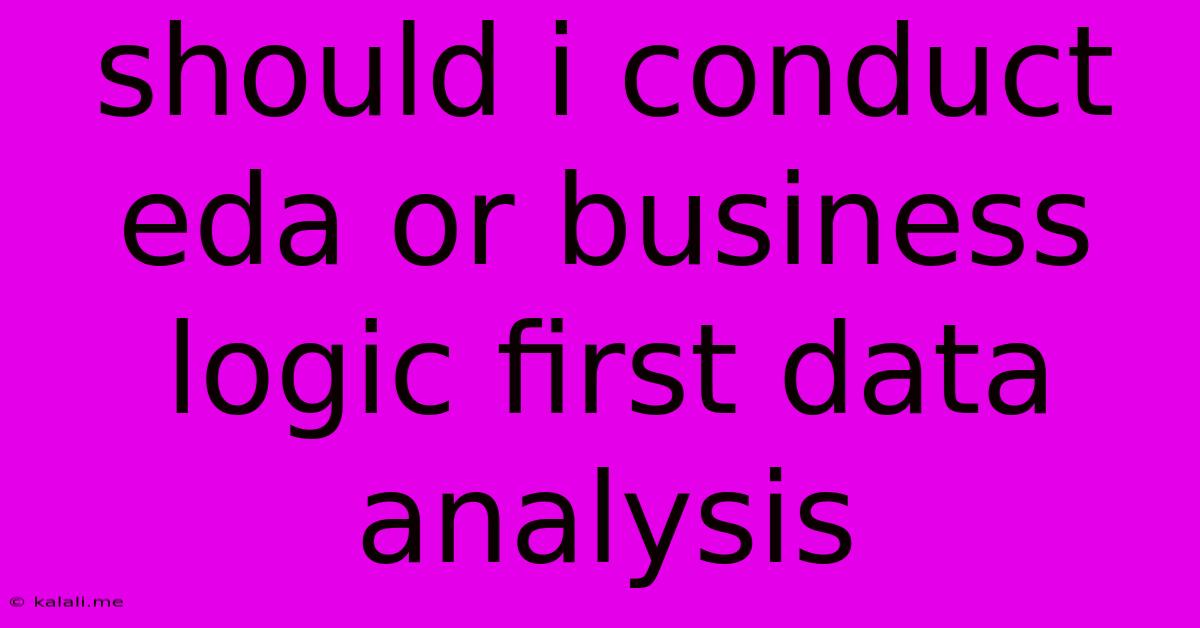Should I Conduct Eda Or Business Logic First Data Analysis
Kalali
May 29, 2025 · 3 min read

Table of Contents
EDA or Business Logic First? Navigating the Data Analysis Workflow
Choosing between Exploratory Data Analysis (EDA) and focusing on business logic first in your data analysis workflow is a common dilemma. The optimal approach depends heavily on the project's context, your data familiarity, and the overall objectives. This article will explore both methodologies, highlighting their strengths and weaknesses to help you determine the best starting point for your next data analysis project. Understanding this crucial decision will significantly improve the efficiency and effectiveness of your data-driven insights.
What is Exploratory Data Analysis (EDA)?
EDA is an iterative and investigative approach. It involves summarizing the main characteristics of the data, identifying patterns, spotting anomalies, and testing initial hypotheses with visual and statistical methods. Think of it as getting intimately acquainted with your dataset before diving into specific business questions. Key techniques include:
- Descriptive statistics: Calculating measures like mean, median, standard deviation, and percentiles to understand data distribution.
- Data visualization: Creating histograms, scatter plots, box plots, and other visualizations to reveal patterns and relationships within the data.
- Data cleaning and transformation: Handling missing values, outliers, and inconsistencies to prepare the data for further analysis.
The Business Logic First Approach
This approach prioritizes framing the business problem and translating it into specific, testable hypotheses before deep EDA. You begin by clearly defining the questions you want to answer, identifying relevant variables, and then focusing your data exploration on those specific areas. This targeted approach can save time and resources by preventing you from getting lost in irrelevant data exploration.
When to Choose EDA First:
- Unfamiliar data: If you're working with a new dataset and lack a clear understanding of its structure and characteristics, starting with EDA is crucial. It allows you to uncover hidden insights and unexpected patterns that might influence your subsequent analysis.
- Open-ended questions: When your analytical objectives are exploratory and you're not working with pre-defined hypotheses, EDA can provide direction and help you formulate meaningful questions.
- Data quality concerns: If you suspect significant data quality issues, EDA is essential to identify and address these problems before proceeding with further analysis. This prevents biased or unreliable results.
- Hypothesis generation: EDA can help you generate hypotheses which then are tested and verified later using more rigorous statistical methods.
When to Choose Business Logic First:
- Well-defined objectives: If you have clear, measurable business goals and well-defined hypotheses, starting with a focused approach can be more efficient. This minimizes the risk of conducting unnecessary analysis.
- Time constraints: When working under tight deadlines, a business logic first approach can ensure you concentrate on the most relevant data and analysis.
- Large datasets: With extremely large datasets, focusing on specific variables early can significantly reduce processing time and computational costs.
- Existing domain expertise: If you possess extensive domain knowledge and understand which variables are most likely to provide insightful results, focusing on business logic can accelerate the process.
A Balanced Approach: The Best of Both Worlds
The most effective approach often involves a combination of both methodologies. You might start with a high-level understanding of the business problem and then conduct a limited EDA to validate assumptions and identify potential issues. This initial EDA can inform the refinement of your hypotheses and guide your subsequent, more focused analysis. This iterative process allows for flexibility and adaptability as you uncover new insights.
Conclusion:
The "EDA first" vs. "business logic first" debate isn't about choosing a winner; it's about selecting the most appropriate strategy for your specific project. Consider the nature of your data, the clarity of your objectives, and available resources when making your decision. Remember, a balanced approach, iteratively combining both EDA and business logic-driven analysis, will often yield the most comprehensive and reliable results. This ultimately leads to stronger data-driven decisions and a more effective overall data analysis process.
Latest Posts
Latest Posts
-
Refrigerator Not Cooling But Freezer Works
May 31, 2025
-
How Do You Turn Off Amber Alerts On Android
May 31, 2025
-
How To Make A Generator Stronger
May 31, 2025
-
How To Remove Ceiling Light Cover
May 31, 2025
-
One Punch Man Manga Online Free
May 31, 2025
Related Post
Thank you for visiting our website which covers about Should I Conduct Eda Or Business Logic First Data Analysis . We hope the information provided has been useful to you. Feel free to contact us if you have any questions or need further assistance. See you next time and don't miss to bookmark.